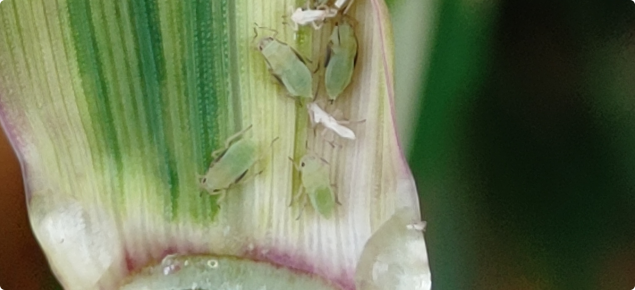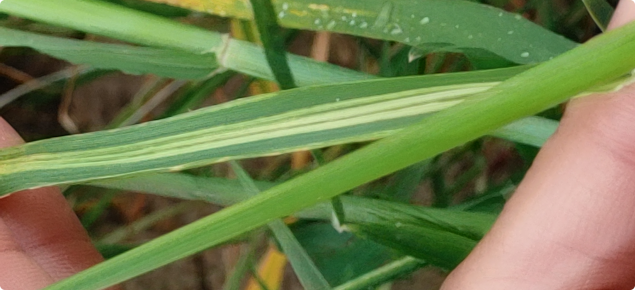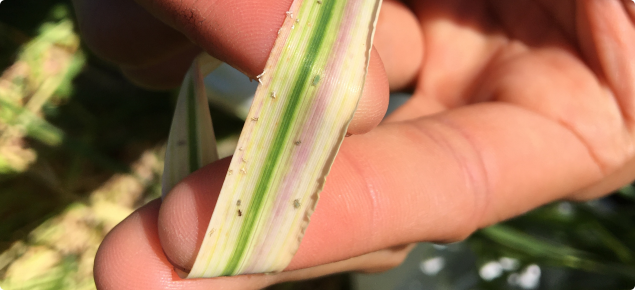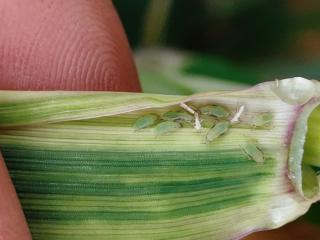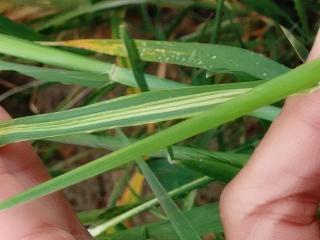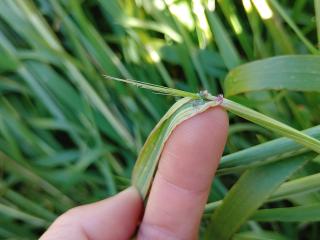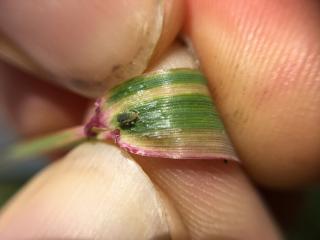Growers, agronomists and consultants are being asked to assist with crop monitoring. Report any aphids or crop damage in cereal crops or grassy weeds, RWA damage looks similar to herbicide or mite damage.
RWA reports and photos should be submitted through one of the following. Samples should only be sent if requested to do so.
- PestFaxReporter app or Pestfax@dpird.wa.gov.au
- DPIRD’s Pest and Disease Information Service (PaDIS) on 9368 3080 or padis@dpird.wa.gov.au
Confirmation of RWA in crops will enable growers to implement proven control methods. Trials and farmer experience in the eastern states over the past four years have determined that with timely and effective treatment, RWA damaged crops can recover to deliver adequate yields.
Impact
Russian wheat aphid (Diuraphis noxia), is pest of wheat and barley, it can be found in grass weeds, like brome and barley grass.
The aphid injects toxins into the plant during feeding which retards growth and with heavy infestations, kills the plant.
Even a few aphids can cause symptoms to appear as early as seven days after infestation. The feeding damage symptoms do not mean there will be yield loss. It is the percentage of tillers with aphids on them that determine whether there will be yield loss.
Trade implications
Presence of RWA in WA is not an international trade issue and there are no trade implications for the WA grain industry, as bulk grain is not a host for Russian wheat aphid.
Following the 2016 detection, the National Management Group (NMG), comprising all Australian governments, Grain Producers Australia and Plant Health Australia, agreed that it was not technically feasible or cost-beneficial to eradicate Russian wheat aphid from Australia.
Aphid identification
RWA appear quite different to other cereal aphids:
- Generally light green in colour.
- Have an elongated body shape, with a bifurcate cauda – ie. two tiny tails at the rear end. These can be difficult to see.
- Distinctive black eyes.
- Lack visible ‘exhaust pipes’ (siphunculi also known as cornicles).
- Up to 2 millimetres long.
- Identification is possible using a hand lens or smartphone macro lens.
Plant symptoms and damage
RWA injects toxins into the plant during feeding which stunts plant growth. Heavy infestations may kill plants.
Plant symptoms associated with the presence of RWA include:
- Leaf rolling along margins.
- White and purple longitudinal streaks on leaves.
- Hooked-shaped head growth from awns trapped in curling flag leaf.
- Heads with a bleached appearance.
- Plant symptoms can look like herbicide damage, nutrient deficiencies or virus symptoms.
- A noticeable loss of green colouration across the crop, stunted plant growth and loss of vigour.
How to look
- Aphids colonise the edges of crops first so it is best to monitor the 20 metre edge of paddocks for signs of aphids or crop damage.
- When inspecting crops it is useful to look at all tillers of a plant, inspect the base of each leaf, and the crown of the plant where aphids may hide.
- Colonies are found most frequently near the base of the youngest leaves or on newly emerged flowers/ seed heads.
- Look for RWA in wheat and barley crops especially crops that are not yet flowering.
Control
Much has been learnt over the past four years from the research and experiences of eastern states growers, demonstrating that timely treatment can be effective and that cereal crops are very resilient, and can recover to deliver adequate yields. Yield impact requires aphids to migrate into emerging crops at an early growth stage (during crop establishment) and to build to high numbers leading up to head emergence.
Thresholds
Do not spray unless necessary. Research investment by the Grains Research and Development Corporation (GRDC) has found the best metric for predicting yield loss from RWA is to determine the percentage of tillers with RWA. On average, for each percent of tillers with RWA there is 0.28 % yield loss.
This research has led to the development of an action calculator to determine RWA yield loss.
Chemicals
No insecticide resistance has been reported in Australia.
As RWA often shelter in the curl of leaves, aphid predators such as lacewings, hoverflies and parasitoid wasps are effective in controlling RWA, so consider applying aphid specific insecticides to preserve beneficials.
Good spray coverage and consideration of weather conditions (temperature, rainfall) in the 24 hours prior and shortly after application are important.
Growers should monitor after spraying to ensure that insecticide is effective and has reached those insects that have sheltered in or under leaf curls.
If crops are past flowering it is too late to spray. Growers will need to start planning for seed dressing for next year.
Refer to the Australian Pesticides and Veterinary Medicines Authority (APVMA) website for current registrations or see DPIRD's Insecticide Spray Guide for Crops below.
Seed treatments
Neonicotinoid seed treatments provide effective early season control of RWA. Preliminary evidence indicates that the length of protection against RWA provided by seed treatments is similar to that observed for other cereal aphid species.
Distribution
Russian wheat aphid is found worldwide, and has spread throughout all major grain growing countries.
In Australia, Russian wheat aphid is present in South Australia, Victoria, southern New South Wales and Tasmania. In August 2020 it was found in a small number of wheat crops in Western Australia and by 2021 has been found in the Great Southern grain growing areas.
In Western Australia - RWA is being found in low, medium and high rainfall areas.
Season of occurrence
Russian wheat aphid can be found throughout the year. Infestation of wheat and barley starts from the emergence of the crop in autumn and extend to crop maturity. RWA can persist over summer on non-crop grasses, research by SARDI has found this aphid on 54 different grass species, predominantly it has been found on barley grass followed by brome, rye grass and wild oats.
Wet summers will promote a green bridge and self-sown wheat and barley will increase RWA survival. Controllinbg volunteer cereals will decrease risk of RWA presence in paddocks.

